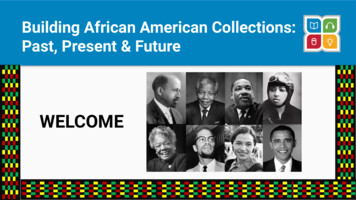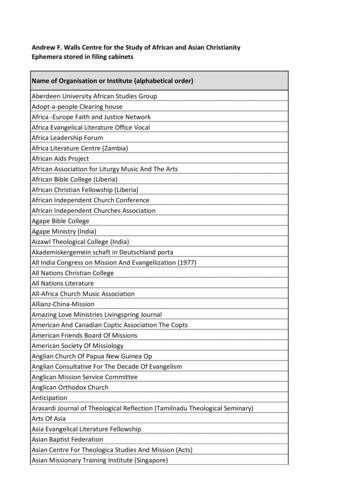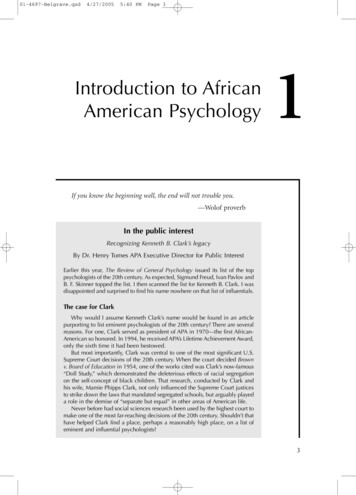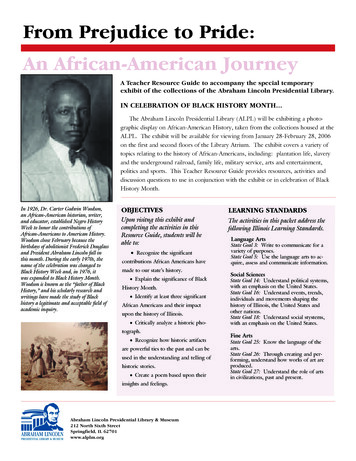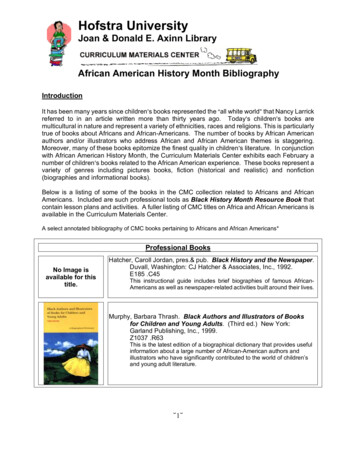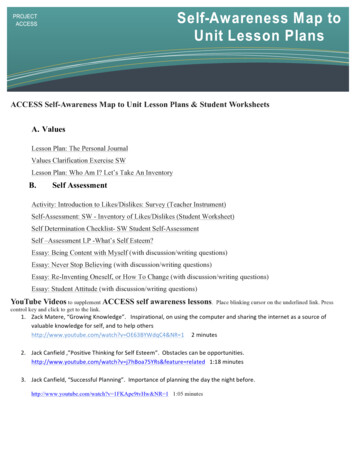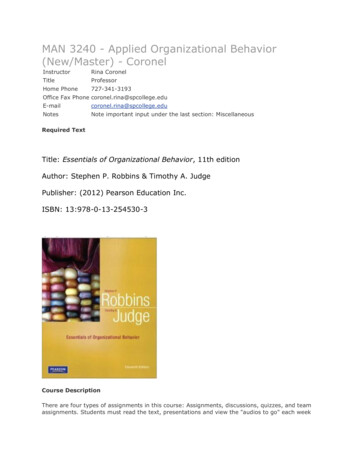
Transcription
http://jct.sciedupress.comJournal of Curriculum and TeachingVol. 5, No. 2; 2016Learning Styles of African American Children:Instructional ImplicationsJanice Ellen Hale1,*1Founding Director of the Institute for the Study of the African American Child (ISAAC), Professor of EarlyChildhood Education, Wayne State University, Michigan 48202, USA*Correspondence: 5425 Gullen Mall, Education Building, Room 213, Teacher Education Division, Detroit, Michigan48202, USA. Tel: 1-248-661-4339. E-mail: janiceehale@cs.comReceived: August 4, 2016doi:10.5430/jct.v5n2p109Accepted: September 9, 2016Online Published: November 24, 2016URL: http://dx.doi.org/10.5430/jct.v5n2p109AbstractThis article offers examples of valiant efforts to develop meaningful instructional implications from learning stylesscholarship. Additionally, an example is given of an advance in the public policy arena that merges the efforts ofpsychological scholars with that of lawmakers to apply their research to effect change for children. The Browndecision was a stellar example in which Lead Attorney Thurgood Marshall and his team were buffeted by thescholarship of Drs. Kenneth and Mamie Clark (1963, 1965). They provided empirical data that documented that the"separate but equal" doctrine of education was psychologically devastating to Negro children. It is recommended thatcontemporary public policy architects follow in their footsteps.Keywords: African American children; African American education; learning styles and instruction learning styles1. IntroductionIt must be borne in mind that the tragedy in life doesn’t lie in not reaching your goal. The tragedy lies in having nogoal to reach. It isn’t a calamity to die with dreams unfulfilled, but it is a calamity not to dream. It is not a disaster tobe unable to capture your ideal, but it is a disaster to have no ideal to capture. It is not a disgrace not to reach thestars, but it is a disgrace to have no stars to reach for. Not failure, but low aim is sin.Dr. Benjamin Elijah MaysThe Late President Emeritus ofMorehouse College and Mentor to MenBenjamin Mays, the legendary president of Morehouse College who was a mentor to Dr. Martin Luther King, Jr.,wrote a book entitled, Disturbed about man (1969). In that book, Dr. Mays wrote:It will not be sufficient for Morehouse College, for any college, for that matter to produce clever graduates,men fluent in speech and able to argue their way through, but rather honest men, men who can be trustedin public and private – who are sensitive to the wrongs, the sufferings, and the injustices of societyand who are willing to accept responsibility for correcting the ills.I thought of Dr. Mays’ words when I began to review the literature related to cognitive, learning, behavioral, culturalstyles of African American children. Elsewhere (Hale, 2016) I have discussed problems in the definition of learningstyles; instruments used to measure learning styles; the lack of a cultural theoretical framework; and lack ofmeaningful instructional implications from learning styles scholarship. In this article, I intend to highlight what hasgone right in learning styles applied scholarship as a companion to highlighting what has gone wrong. It is my hopethat these examples will stimulate future scholarship in this vein.Published by Sciedu Press109ISSN 1927-2677E-ISSN 1927-2685
http://jct.sciedupress.comJournal of Curriculum and TeachingVol. 5, No. 2; 2016We must continue to develop meaningful instructional implications of learning styles scholarship as we seek toimprove the scientific foundation it is based upon – African American children cannot wait. I have identified severalstudies that represent valiant efforts that should be highlighted. Two studies (Melear and Richardson, 1994; Watkins,2002) grappled with various stages of moving from theory to hypothesis to the collection of empirical data. Twostudies (Diller, 1999; Rowser and Koontz, 1995) made the attempt to go from theory to classroom practice. Thearticle by Diller shares the journey of a white teacher who seeks mentoring in using culturally appropriate pedagogyin her classroom of African American children in the area of literacy. The article by Rowser and Koontz applyHillard’s (1989) cultural styles themes to mathematics instruction. The scholarship of Anderson (1988) and that ofMcDermott, Piternick, and Rosenquist (1980) provide examples in the discipline of science where cultural themesenhance pedagogy. The scholarship of Coggins, Patrick and Campbell (2008) is highlighted as an example ofconnecting the cultural perspective to the arena of public policy. It is of critical importance to move beyond arguingamong ourselves about who is right and who is wrong to begin to interpret what we know to school districts,legislators and those who make public policy.Melear and Richardson (1994) created an overlay with the cultural themes identified in my book (Hale, 1982) andcollected data corroborating my hypotheses. She collected data in four counties in North Carolina to determinewhether the learning styles I described (Hale, 1986) could be identified among African American elementary andhigh school males through the use of the MBTI. Learning styles differences between the white and African Americanmales were found for children in the 6th and 11th grades. Differences were not found for students above the 12th gradean interpretation is that perhaps those with non-mainstream learning styles may have dropped out by the 12th grade.Angela Watkins (2002) designed a study to explore empirical validation of the cultural themes of communalism andcooperative learning described in the scholarship in my early work. (Hale, 1982, Hilliard, 1976, Boykin 1983 andothers). Her study explored help-seeking behaviors among forty-four 2- to 5 year old African American girls andboys. She coded observed help-seeking behaviors and tallied variable frequencies (source of help, age, type of helpsolicitation, and kind of activity). Associations between variables were examined.Her findings demonstrate that preschoolers tend to go to peers in request of academic help. This implies that AfricanAmerican preschoolers are ready and willing to work in cooperative learning structures. The data revealed thatchildren approached teachers more than peers for social help. She also studied the developmental nature ofcommunalism and cooperation at the preschool level for African American children. There was evidence that eventhough toddlers sought help more than preschoolers, both toddlers and preschoolers tended to approach peers morethan teachers for help.3. LiteracyDebbie Diller (1999), a white classroom teacher wrote a very perceptive article in which she drew upon thescholarship in my first book (Hale, 1986) and that of others (Smitherman, 1977; Delpit, 1988, 1992; Strickland,1994). She identified the points of disconnect between her teaching and the responses of the African Americanchildren she taught. She sought mentorship from African American teachers and scholars about the learning styles ofthe children. She used this mentorship and her observations to identify strategies for teaching to the learning styles ofthe children in her classroom. She also created new strategies for working with African American parents.I am highlighting this article because Diller exemplifies the path we need to take as we seek to create the scientificfoundation called for in generating this innovative pedagogy. She began by reading the scholarly literature onAfrican American culture and learning styles. She then sought mentorship from friends who were African Americanteachers. Next, she created a study group within her elementary school building where the learning and culturalstyles of the African American children were discussed. She observed in the classrooms of African Americanteachers who were successful in teaching African American children and recorded their strategies. She attendedseminars on vernacular Black English and mastered the fine points of culturally appropriate literacy strategies withAfrican American children. Once she formulated the strategies, she consulted with an African American scholar (Dr.Lisa Delpit) for support, refinement and validation of her strategies. This article is highlighted, not because thestrategies are empirically documented. The article is highlighted because of the paths she took in generating them.This odyssey of Diller epitomizes the dynamic collaboration between White and African American teachers andscholars that are needed to push this frontier.Given the fact that this area of inquiry is in its infancy, we need to capitalize upon the insights of scholars andpractitioners to create this dynamic collaboration.Published by Sciedu Press110ISSN 1927-2677E-ISSN 1927-2685
http://jct.sciedupress.comJournal of Curriculum and TeachingVol. 5, No. 2; 2016Among the insights that Diller gleaned from her inquiry were:1. Cultural discontinuity was identified as a central problem. She observed the mismatch between the culture of theschool and the culture of the home. She videotaped her class with the camera focused on the children, not on her asthe teacher.2. Incorporation of multicultural literature in instruction. Her African American teacher/mentors revealed to her thatthere is a disconnect between African American parents and libraries. This results in under usage of the library inAfrican American communities.3. The power of speaking to the children “like their mommas do.” African American teachers pointed out thatAfrican American children like explicit language rather than an inductive, indirect, questioning voice.4. The children learned best with the comfort and stability of a daily school routine with minimal changes orinterruptions.5. African American teachers recommended the teaching style that parallels the performer style describe in my firstbook (“Author”, 1986) which captured the children’s attention.6. Incorporating the “feel” to learning recommended by African American teachers that incorporate the rhythm,rhyme and movement discussed in my first book (“Author”, 1986). She found that the children found delight inchanting and moving to the beat of poetry.7. She also noticed that the children embraced the cultural themes highlighted in my first book (Hale, 1986) ofcooperation and sharing. She noticed that when she structured cooperative learning activities, most of the childrenappeared to be more engaged. For example, the children observed a spider hanging from their classroom ceiling.They began to research information about spiders. The children became very interested in the topic. Most of thechildren chose to work with partners to write and share their research on spiders. They enjoyed the support of theirclassmates.8. This White teacher became more comfortable talking about race. So, when a child accused her of not liking himbecause he was Black, she followed Paley’s example in White Teacher (1979):I handled the matter head-on. I held out my hand beside his and said, ‘You do have black skin and I havewhite, but that doesn’t mean I don’t like you.’ I explained that my job was to help each child in ourclassroom, and that although I sometimes didn’t like his actions, I did like him. I gave him examples untilhe began to giggle. ‘I like you because you help other children and show them how to do things. Butsometimes you start yelling, and it bothers the other kids who are trying to learn. You need to just tell thatold tongue of yours to control itself. You’re the only one who can do that. I can’t grab your tongue andmake it quiet, can I?’ Brian never played the race card with me again (p. 824).9. Absorbed the literature on the situational rules of communication. Through this pathway, she was able to honor thevernacular linguistic culture of African American children while teaching them to code-switch to master mainstreamlanguage for success in school and upward mobility.10. She began to read stories from Taylor and Dorsey-Gaines’ (1988) Growing Up Literate. These were stories aboutfamilies with limited economic resources that provided abundant literacy opportunities for their children. Shedismissed her preconception that children of poverty had limited literacy experiences. She began to interview thechildren about literacy experiences in their homes. They were questioned about favorite books, people who read ortold stories to them and about the kinds of activities they did with their families. She compiled the data and plannedclassroom activities that built upon the information gathered. She found that that the children enjoyed playing cardsand games at home with their families, so she included more sight words and spelling words in the format of cardgames.An ABC News special report, (Holm, 1993), “Common Miracles: A New Revolution in Education” highlightedinnovative schools that had a “games” room. The children played various games so that they could identify thedelight they garnered from those activities. The teachers then sought to transfer that enjoyment to engaging inclassroom learning activities.11. She encouraged parents to volunteer in the classrooms. She asked them to read aloud to small groups of children;let them hold hands with the children as they walked to lunch. She noticed that “the children seemed more relaxedwhen someone who looked like their mother was there to help. They’d sometimes open up and tell the parent helpersthings they’d never tell the teacher.”Published by Sciedu Press111ISSN 1927-2677E-ISSN 1927-2685
http://jct.sciedupress.comJournal of Curriculum and TeachingVol. 5, No. 2; 201612. She engaged the parents in telling the teacher about their children outside of school.13. The parents appreciated having the teacher model reading to their children. The parents appreciated the explicitdemonstrations. They admitted that they didn’t know the best way to help their child academically and were reluctantto do anything because they didn’t want to “mess up” what the schools were doing.Some African parents told me that they have accents and didn’t read to their children because they wereafraid their accents would confuse their youngsters. I asked them if they talked to their children with theiraccents and they said that they did. ‘Did your child learn to talk?’ I’d ask. They’d smile and realize thatthey weren’t harming their children (p. 828).14. Her focus was to adapt her teaching rather than try to get the children to change.She agreed with Shields (1995) that the more teachers acknowledge, respect, and build on the skills, knowledge,language, and behavior patterns that children bring to school, the more likely children will become engaged inacademic learning.15. She agreed with the research that documents the high degree of physical movement on the part of AfricanAmerican children, particularly males. She agreed that it enhanced the achievement of the children whenopportunities were provided for active learning. As she experimented with rhythm, rhyme, movement, interactivediscussion, cooperative activities in a structured school environment, she began to see many more of the children inher classroom succeed.4. MathematicsJacqueline Rowser and Trish Koontz (1995) share my judgment that even though an interest in learning stylesblossomed in the 1970’s, that scholarship was rarely implemented in the classroom. They suggest that teachers feltthat time constraints and other roadblocks made matching a student’s cultural learning styles with teaching stylesunrealistic. Rowser and Koontz juxtaposed Hilliard’s (1976: 38-39) taxonomy of cultural styles with learningactivities they observed in classrooms.4.1 Many African American Students Tend to Respond in Terms of the Whole Picture Instead of its Parts“For example, when studying quadrilaterals, investigate all of the quadrilaterals at the same time, look for similaritiesand differences instead of studying one shape at a time. A sample introductory lesson follows.In small groups of two or three students, have students sort the quadrilaterals in figure 1 into two sets. The studentsmust determine the attribute used to sort the shapes. Ask each group to explain how they sorted the shapes into thetwo sets. Some students will sort by parallel sides or by shapes with right angles. Others will sort by equal sides, byfat and skinny shapes, or perhaps by straight and tilted sides. All of the reasons should be accepted. The idea thatshapes can be investigated along many different dimensions is important.Figure 1. Quadrilaterals to SortPublished by Sciedu Press112ISSN 1927-2677E-ISSN 1927-2685
http://jct.sciedupress.comJournal of Curriculum and TeachingVol. 5, No. 2; 2016Next ask each group to sort the quadrilaterals into three sets: shapes with two pairs of parallel sides, orparallelograms; shapes with only one pair of parallel sides or trapezoids; and shapes with no parallel sides. Thestudents should continue to investigate each subgroup as a whole while looking for specific characteristics by whichthey could establish another subgroup, as shown in figure 2.Figure 2. Quadrilaterals Flowchart4.2 Many African American Students Tend to Prefer Inferential Reasoning to Deductive Or Inductive ReasoningThroughout history, inference has played a vital part in constructing mathematical knowledge and must not bethought of as an inferior way of knowing. According to Joseph (1987: 22-26), it is generally accepted thatmathematical discoveries develop only after rigor in deductive axiomatic logic is used. Thus, intuitive or empiricalmethods are viewed as having little, if any, mathematical value. However, ancient mathematical documents, such asthe Moscow Papyrus (c. 1980 B.C.) are considered valid proofs without being symbolic.An inference is a judgment made from observations or evidence. The evidence, however, can be misleading and canlead to a faulty judgment. For example, a student may infer from a drawing that a triangle is a right triangle when infact it may not be.Inductive reasoning forms generalizations from many specific cases. Like inference, the generalizations may not beaccurate when the observations are not accurate or when all possible cases have not been studied. An example offaulty inductive reasoning might be the following. After converting a page full of fractions, such as ½, ¾, 7/8, 2/5,and 5/8, into decimals. LeRoy concluded that all fractions can be made into decimals that do not repeat.Deductive reasoning proceeds from a general statement, includes a specific statement satisfying the hypothesis of thegeneral statement, and then leads to the conclusion. For example, if the perimeter of a square is four inches and asquare has four equal sides, then each side is one inch long.Both deductive and inductive reasoning rely heavily on many pieces of detailed information. Hilliard (1976: 38)points out that the preoccupation with specifics – too many individual details or cases – at the possible loss of a senseof the whole tends to disturb the learning style of many African American students. For these students, the gestalt,not the particular, is often more important. An analogy can be made with teaching writing: teachers stress theimportance of expressing the thoughts first before examining details of grammar. Although a need to teach inductiveand deductive reason exists, teachers should respect the fact that many African American students approach logicfrom a different perspective. Inference is an important step in constructing mathematical knowledge. Encourage allstudents to discuss what they have inferred from models and story lines. Help them reflect on and clarify theirinferences by offering an open and accepting environment for all reasoning skills.Published by Sciedu Press113ISSN 1927-2677E-ISSN 1927-2685
http://jct.sciedupress.comJournal of Curriculum and TeachingVol. 5, No. 2; 20164.3 Many African American Students Tend to Approximate Space, Number, and Time Rather than Stick to AccuracyGenerally in the United States, promptness and accuracy are expected. However, in studying mathematics,approximations can be just as important as accuracy. Children, in the past and now, are convinced in school thatmathematics is the study of the precise and that only one correct answer and only one correct algorithm are possible.The National Council of Teachers of Mathematics recommends in the Curriculum and Evaluation Standards forSchool Mathematics (1989: 37) that children investigate and understand when it is appropriate to estimate and whenit is appropriate to calculate an exact answer. If indeed many African American students tend to approximate space,number, and time, teachers need to recognize this approach as an asset, not a deficit. Helping all students recognizethat both approximations and precise answers are appropriate depending on the given situation is of utmostimportance.If only exact answers are stressed throughout students’ K-12 experiences, then the majority of students would answerthe following problem incorrectly. A certain large airplane holds 312 passengers. If 30,316 people want to fly fromNew York to Paris on this type of airplane, how many airplane trips will be needed to fly all of the people to Paris?In the Mathematics Education Trust’s “Testing Using the Calculator Test,” over 60 percent of the participants usingcalculators chose 97.166 66 trips as their answer. Teachers need to encourage all students to recognize that an exactanswer is not always reasonable.Primary teachers help children develop number sense in the early years by accepting a response that eight blocks willfit into a box designed to hold ten blocks. The teacher encourages the child by placing the eight blocks in a box andsaying, “Yes, eight will fit into the box. Can you find another number of blocks that also might fit? Is a closer fitpossible?” Secondary teachers also need to respect approximations as part of number sense. Many secondarystudents become frustrated with factoring because they have been trained to think that their first guess should be thecorrect answer. For a student who tends to learn through approximations, a teacher’s expectations of exact answerstoo soon or all the time can create unnecessary frustration. Teachers should discuss with students when and why anapproximation is acceptable and when an exact number is necessary. Clearly makes this procedure part of theteaching routine.4.4 African American Students Tend to Prefer Novelty, Freedom, and Personal DistinctivenessBy using a variety of assessments, teachers can better accept alternative forms of expression. For example,mathematics can be applied to art, music, and architecture. By including real-life applications of mathematics,teachers help students make more conceptual connections. Making presentations, writing in journals, buildingmodels, and other individual or group assignments can increase interest and success in mathematics by offeringstudents the freedom to express their mathematical knowledge in alternative ways. For example, students should beassigned a data-analysis project requiring them to choose a topic, design the study, collect and analyze the data, andchoose appropriate ways to display and report their findings. When students are given the freedom to choose topicsimportant to them, their completed projects will often exceed the teacher’s expectations. Students may choose toanalyze data about religion, dress, sexual preference, or environmental concerns, to name a few possible topics.Another project may request that students design a student recreation center. The cost of the building depends oncubic feet of space, materials used, necessary furniture and equipment, labor costs, and other details decided on bythe class. Applying many rich geometry and algebra concepts becomes necessary when completing this project.What perimeter of the building makes the largest area? Is floor space directly related to the volume of the structure.Would a three-story building be more economical than a one-floor plan? Is economics always the deciding factor in adesign? These two examples give students the freedom to show their individual creativity.In sum, when teachers become more aware of, and sensitive to the diverse learners in a given classroom, they will bemore likely to implement a variety of pedagogical techniques that will enhance learning for all students.5. ScienceIn the Preface to the 2nd Edition of my first book (Hale, 1986: xv), A call was made for more documentation of thereasons for the success of Black colleges in educating Black students. Such documentation would support theprovision of a distinctive educational experience for Black children at earlier ages. The suggestion that AfricanAmerican children would benefit from a culturally congruent post-secondary experience is not as virulently attackedby the educational establishment as the proposal that preschool, elementary, and secondary education should bechanged. Presumably, the White establishment doesn’t attack the concept that Black colleges produce success withPublished by Sciedu Press114ISSN 1927-2677E-ISSN 1927-2685
http://jct.sciedupress.comJournal of Curriculum and TeachingVol. 5, No. 2; 2016African American students because what they do does not affect them. This laissez faire attitude ends when it issuggested that there should be a change in the schools that white children attend. Because the establishment is not asthreatened by the documentation of cultural themes that can be found in the success of Historically Black Collegesand Universities (HBCUs), it might be easier to secure funding for such studies. I was told by a White educator thatby and large, White parents don’t object to African American children receiving a quality education. They just don’twant to change the schools as they presently exist to achieve that. The fear is that change might have a deleteriouseffect on the achievement of White children.Anderson (1988) points out that the most successful science/pre-medicine programs in the country can be found atXavier University in New Orleans. Xavier, a historically Black University places more African Americans inmedical school than any other university in America. Not only do they place more students who are admitted tomedical school, they produce more Black students who graduate and achieve their medical degrees than any otherinstitution. He notes that:. . .”the program builds confidence and skill in its predominantly black population by creating an aura of familyin which cooperation is highly valued, bonding between the students and faculty is encouraged, and amaintenance of positive ethnic identity is fostered. Learning occurs in a socially reinforcing environment.Incidentally, the director of the program is a white male. One does not have to be the same race/ethnicity toidentify and capitalize upon the cultural/cognitive assets of minority populations.” (p. 8)Included in this discussion should also be the legendary dual degree program in Business Administration at FloridaA&M University that was created by Dr. Sybil Collins Mobley. The Florida A&M University (FAMU) School ofBusiness and Industry (SBI), under the leadership of the founding dean, Dr. Sybil Collins Mobley, was established in1974 to prepare talented students from around the nation and the world to not only survive, but to thrive in acompetitive global market place. Nearly four decades later, the outstanding record of SBI’s achievements is knownworldwide, especially among corporate executives and recruiters who frequently visit SBI to observe and review itsacademic, professional development and internship programs as well as to recruit SBI students. Tom Peters, in hisbestselling book, A Passion for Excellence,(1984), described SBI as “the Marine corps of business schools: pride,poise, excellence!”Anderson (1988) points out further that African American students encounter problems when they attempt to adaptto the theoretical, often abstract reasoning process that is utilized in mathematics and the hard sciences. Most coursesin both math and science teach the theory of the discipline in an abstract sense before the student is exposed to thepractical applications in laboratory exercises. This has always been the sequence of training in mathematics andscience and coincides with the Anglo-European cognitive style, especially that of males. The approach of givingstudents direct experience with applications of formal concepts and laws is not as valued and utilized as much byteachers. I cannot help but interject here that when I attended high school in an inner city, defacto segregated school,no laboratory experiences were provided in biology. My first exposure to a biological lab was as a freshman atSpelman College. So, even if a teacher wanted to put a laboratory experience first, there was no opportunity to do so.McDermott, Piternick, and Rosenquist (1980) found such an approach to be extremely successful in helping minoritystudents succeed in physics and biology at the University of Washington. Brown (1986) at the University of SanDiego found that the same approach worked in her mathematics lab.6. Public Policy Arena: Thurgood Marshall Needed Kenneth Clark – Brown Decision 1954There is a law in Florida, The African and African American History Law (Florida Statute 233.061 [1] [f] ) thatcreates a fiduciary obligation and requires that African American History be infused into all courses and at all gradelevels from PreK-12 in all Florida public schools. All elected officials (school board members, legislators,superintendents) as well as other educators are obligated to ensure that the spirit and intent of this law are carried out.This obligation extends to those in higher education to design teacher training programs that can implement thecourses in the classrooms in which they teach. I would like to know who the legislative team was in the Florida StateLegislature that design
African American children like explicit language rather than an inductive, indirect, questioning voice. 4. The children learned best with the comfort and stability of a daily school routine with minimal changes or interruptions. 5. African American teachers recommended the teaching style that parallels the performer style describe in my first
